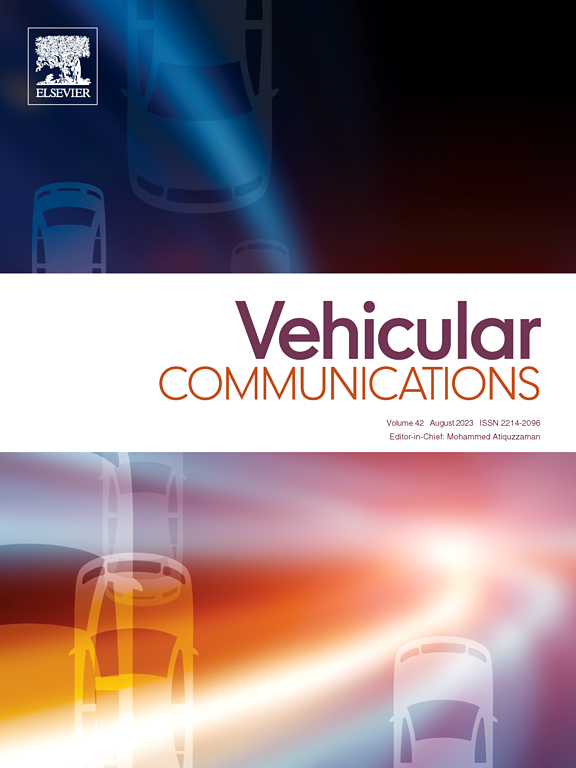协作、互联和自动移动(CCAM)的轻安全方案
IF 6.5
2区 计算机科学
Q1 TELECOMMUNICATIONS
引用次数: 0
摘要
协作、互联和自动交通(CCAM)是学术界和工业界采用的一种新模式,旨在为各种道路(高速公路、城市和农村道路)提供安全、可靠和可持续的交通。CCAM利用协作式智能交通系统(C-ITS),通过所有相关参与者(车辆、道路基础设施、行人等)之间的沟通与合作,提高安全性并减少交通拥堵。在欧洲和美国,已经提出了适应的通信协议,以确保通过交换特定消息进行合作。在本研究中,我们重点关注欧洲协议,特别是由欧洲电信标准协会(ETSI)定义的合作感知消息(CAMs)。摄像头由包含车辆状态信息(速度、位置、航向等)和附加安全信息的有效载荷组成。该信息包括一个假名证书(PC)和一个签名,以保证发送者的身份验证。然而,由于车辆以1至10赫兹的频率定期发送cam,因此向有效载荷添加安全数据会显着增加通信通道的负载和带宽。我们提出了一种新的方法,允许车辆在第一次相遇时对彼此进行身份验证,而不是彻底的身份验证。一旦达到这个信任级别,车辆就会在一段可变的时间内(称为信任期)停止发送经过身份验证的消息。此外,我们提出了一个信任验证过程,以避免在此信任期间的恶意活动。我们的方法大大减少了发送签名的cam的数量,验证和签名计算,从而减少了通信开销。在omnet++平台上进行的模拟测试表明,我们的方法显著降低了通信开销,将cam交换量减少了56%。本文章由计算机程序翻译,如有差异,请以英文原文为准。
Light security scheme for Cooperative, Connected and Automated Mobility (CCAM)
Cooperative, Connected and Automated Mobility (CCAM) is a new paradigm adopted by academia and industry in order to provide safe, secure and sustainable mobility on all kinds of roads (highways, urban and rural roads). CCAM takes advantage of Cooperative Intelligent Transport Systems (C-ITS) to improve safety and to reduce traffic congestion thanks to communication and cooperation among all relevant actors (vehicle, road infrastructure, pedestrians, etc.). In Europe and the USA, adapted communication protocols have been proposed to ensure cooperation through the exchange of specific messages. In this study, we focus on the European protocols, particularly the Cooperative Awareness Messages (CAMs) as defined by the European Telecommunications Standards Institute (ETSI). CAMs are composed of a payload containing information about the vehicle status (speed, location, heading, etc.) and additional security information. This information includes a Pseudonym Certificate (PC) and a signature to guarantee the sender's authentication. However, since CAMs are sent periodically by vehicles at frequencies from 1 to 10 Hz, this addition of security data to the payload significantly increases the load and bandwidth of the communication channel. Instead of exhaustive authentication, we propose a new approach that allows vehicles to authenticate each other for the first time when they meet. Once this level of trust is reached, vehicles stop sending authenticated messages during a variable period of time (called a trust period). In addition, we propose a trust verification process to avoid malicious activities during this trust period. Our approach significantly reduces the number of signed sent CAMs, the verification and signature computations, leading to reduce communication overhead. Simulation tests conducted over the OMNET++ platform demonstrate that our approach leads to a significant decrease in communication overhead, reducing the volume of CAMs exchanged by 56%.
求助全文
通过发布文献求助,成功后即可免费获取论文全文。
去求助
来源期刊

Vehicular Communications
Engineering-Electrical and Electronic Engineering
CiteScore
12.70
自引率
10.40%
发文量
88
审稿时长
62 days
期刊介绍:
Vehicular communications is a growing area of communications between vehicles and including roadside communication infrastructure. Advances in wireless communications are making possible sharing of information through real time communications between vehicles and infrastructure. This has led to applications to increase safety of vehicles and communication between passengers and the Internet. Standardization efforts on vehicular communication are also underway to make vehicular transportation safer, greener and easier.
The aim of the journal is to publish high quality peer–reviewed papers in the area of vehicular communications. The scope encompasses all types of communications involving vehicles, including vehicle–to–vehicle and vehicle–to–infrastructure. The scope includes (but not limited to) the following topics related to vehicular communications:
Vehicle to vehicle and vehicle to infrastructure communications
Channel modelling, modulating and coding
Congestion Control and scalability issues
Protocol design, testing and verification
Routing in vehicular networks
Security issues and countermeasures
Deployment and field testing
Reducing energy consumption and enhancing safety of vehicles
Wireless in–car networks
Data collection and dissemination methods
Mobility and handover issues
Safety and driver assistance applications
UAV
Underwater communications
Autonomous cooperative driving
Social networks
Internet of vehicles
Standardization of protocols.
 求助内容:
求助内容: 应助结果提醒方式:
应助结果提醒方式:


